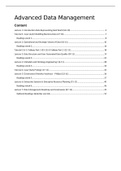Samenvatting
Summary Advanced Data Management Lectures and Papers 2021
- Instelling
- Tilburg University (UVT)
Summary of the course -M-6 Advanced Data Management lectured by Dr. Arash Saghafi in 2021 (block 2). All lectures, lecture slides and notes have been included in this summary. Also a very brief summary of the readings for this course are included in this document.
[Meer zien]




